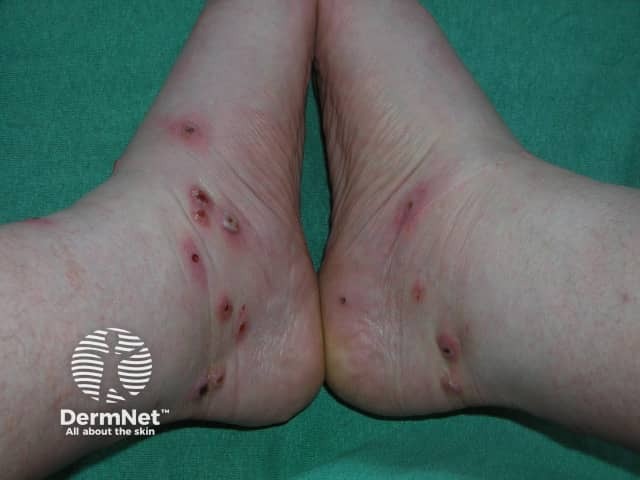Main menu
Common skin conditions

NEWS
Join DermNet PRO
Read more
Quick links
Leeches — extra information
Introduction - leeches in medicine Current use Origin and biology Complications
What are leeches and their use in medicine?
Leeches are bloodsucking worms that have been used in medicine as far back as 2500 years ago. In ancient and medieval times it was believed that an imbalance in the proportions of certain body fluids caused illness. Bloodletting using leeches was one method used to restore balance and bring good health. Leeches were thought to be able to cure numerous medical conditions including headaches, brain congestion, obesity, haemorrhoids, eye disorders and mental illness, and were used right up until the 1960's.
Infected leech bites from wading through a tropical stream

Infected leech bites
Use of leeches today
Between 1960 and 1980 the use of leeches for bloodletting declined significantly. In the 1980's interest in the use of leeches for other therapeutic purposes resurfaced with the arrival of plastic and reconstructive surgery. One of the biggest problems with this kind of surgery is blood clotting which stops the flow of fresh blood between old and new tissue. Leeches produce substances that overcome these problems. Leeches have been used to restore blood circulation to grafted or severely injured tissue. The practice of using leeches in medicine today is known as hirudotherapy.
Hirudotherapy is mainly used in trauma and plastic and reconstructive surgery to salvage tissue flaps and skin grafts whose viability is threatened by venous congestion. Physicians are discovering other conditions where the practice may have a role to play. These include:
- Herpes zoster (shingles)
- Boils and abscesses
- Venous congestion
- Ear infections
- Sinusitis
- Tonsillar abscess
- Thrombosis (blood clot)
- Thrombophlebitis
- Hypertension
- Hyperthyroidism
- Osteoarthritis
- Cholecystitis
- Orchitis
Where do leeches come from and how do they work?
Leeches are primarily found in freshwater lakes, ponds or rivers. Historically, leech collectors would wade in leech-infested waters collecting these as they allowed the leeches to attach themselves to their legs. The problem with these leeches is they carry in their gut the bacteria Aeromonas hydrophilia, which can be passed to the patient during therapy and cause pneumonia, septicaemia or gastroenteritis.
Nowadays, leeches for medical use are bred in laboratories under sterile conditions in order to reduce secondary infections in patients. There are 2 species of therapeutic leeches, Hirudo medicinalis (European medical leech) and Hirudo michaelseni.
Leeches work by attaching themselves to the patient by means of their 2 suckers (located at either end of their bodies). One of these suckers surrounds the leech's mouth, which contains 3 sets of jaws that bite through the patient's skin, making a Y-shaped incision. As the leeches suck the blood they release certain chemicals via their saliva and this delivers the main therapeutic benefits of hirudotherapy.
- Anticoagulant enzymes – leeches secrete an anticoagulant called hirudin that stops the blood from clotting. This action can last up to 6 hours after the leech is detached from the patient, and effectively drains away the blood that could otherwise accumulate and cause tissue death.
- Local anaesthetic – this numbs the area so much so that the patient feels hardly any pain, other than the initial bite. Often, people bitten by leeches in nature are unaware of it until afterwards when they notice a Y-shaped incision and a trickle of blood that is hard to stop.
- Vasodilator and prostaglandin – helps reduce swelling.
The feeding process of a leech usually lasts about 20-40 minutes where 10-15ml of blood is ingested and their body size may increase 8-11 times their original size. Once the leech is full it will release itself and drop off. However, if leeches need to be removed by hand, their grip should first be loosened with heat, alcohol, or acid before pulling them off. Forcibly pulling them off may leave their jaws behind in the wound.
Complications of hirudotherapy
Possible complications of hirudotherapy include:
- Infection caused by bacteria and other microorganisms that the leech may carry and pass on – it is recommended that all patients who have leech therapy should receive broad-spectrum antibiotics to prevent leech-related infections, especially with Aeromonas hydrophila.
- Excess blood loss – it is necessary to monitor the amount of blood removed since a drop in red blood cell counts can occur in rare cases of prolonged bleeding.
- Loss of leeches in body orifices and spaces.
- Allergic reactions such as pruritus (itching), weal formation and blisters.
- Foreign body reaction against leech jaw that can remain in tissue when leech forcibly removed.
- Necrosis with a chronic progressive ulcer due to leech bite toxin or antigens in leech saliva.
References
- Book: Textbook of Dermatology. Ed Rook A, Wilkinson DS, Ebling FJB, Champion RH, Burton JL. Fourth edition. Blackwell Scientific Publications
- Leeches: Dr Joseph F. Smith Medical Library
- Hirudo medicinalis: Animal Diversity Web
- Giltner CL, Bobenchik AM, Uslan DZ, Deville JG, Humphries RM. Ciprofloxacin-resistant Aeromonas hydrophila cellulitis following leech therapy. J Clin Microbiol. 2013 Apr;51(4):1324-6. doi: 10.1128/JCM.03217-12. Epub 2013 Jan 30. PubMed PMID: 23363826; PubMed Central PMCID: PMC3666766.
On DermNet
Other websites
